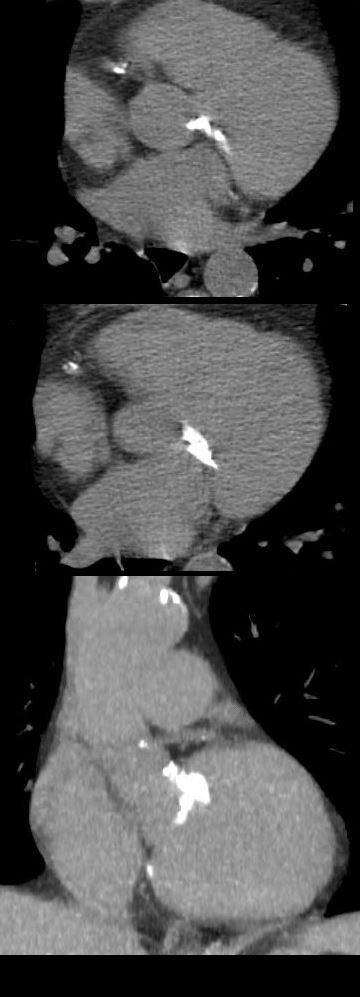
Hi Patrick
- I have outlined an overview of MAC and highlighted the relevance to our patient who had CAD.(Abramovitz is an excellent article if you have time)
The relationship of the aortic and mitral valve goes back a long way (for your own interest I wrote a little poem about the relationship) - re the Aortic Annular Calcification Suffice just to mention that is related to atherosclerosis in other vascular beds. (as is MAC)
- Examples
- Our Case
- MAC IHD and Prior Infarction
- The fat and calcium in the LV apex indicates prior MI
- Extensive MAC with heart block MR and mild MS
- MAC and Caseous Necrosis
- MAC Dextrocardia and Bacterial Endocarditis
Start here
Mitral Annular Calcification
- Degenerative process associated with
- aging,
- cardiovascular risk factors.
- Degeneration from increased mitral valve stress
- Aortic Stenosis
- Hypertension
- Hypertrophic Cardiomyopathy
- Also seen in
- chronic kidney disease, (Ca PO4 disorder)
- following radiation therapy.
- Associated with
- arrhythmias and heart blocks
- MS and MR are rare
Our Case
Mitral Annulus and Aortic Annulus Calcification

Other Examples
MAC and IHD

56 year old male with history of coronary artery disease. Axial CT through the heart shows apical curvilinear fat (yellow arrowheads, ( a and b) associated with apical myocardial dystrophic calcification (green arrowheads c and d) both indicating prior apical MI. In addition there mitral annular calcification (red arrowhead, b) and multifocal fatty deposits in the RV (white arrowheads, a and b) usually depicting age related degenerative changes. The calcification in the annulus is premature and unusual for this 56 year old male patient. Note the small bilateral pleural effusion The association of atherosclerosis and MAC are well known. Premature MAC should therefore be a warning for premature heart disease.
Ashley Davidoff MD
Examples of Uncommon Complications
Heart Block, MR and MS
SEVERE MITRAL ANNULAR CALCIFICATION
Axial CT through the mitral annulus shows severe mitral annular calcification extending into the ventricular cavity and the ventricular septum.
MAC and Caseous Necrosis
 MAC and CASEOUS NECROSIS
MAC and CASEOUS NECROSIS
69 year old female with MAC who presents with an echo finding of a mass on the mitral valve thought to represent a myxoma. CT confirmed a low-density mass measuring in the soft tissue range associated with mitral annular calcification.

. MRI showed a mass in the region of the posterior leaflet of the MV with T2 hyperintensity suggesting aqueous component and T1 hyperintensity suggesting increased protein content. There was no enhancement of the lesion. Peripheral T1 and T2 low intensity reflects calcification. A diagnosis of caseous necrosis of MAC is most likely

MRI showed a mass in the region of the posterior leaflet of the MV with T2 hyperintensity suggesting aqueous component (upper image) and focal T1 low intensity nodule on the posterior leaflet reflects the MAC There was no enhancement of the lesion. A diagnosis of caseous necrosis of MAC is most likely
MAC Dextrocardia and Bacterial Endocarditis
 DEXTROCARDIA, MAC and BACTERIAL ENDOCARDITIS
DEXTROCARDIA, MAC and BACTERIAL ENDOCARDITIS
Links and References
Abramovitz Y et al Mitral Annulus Calcification. J Am Coll Cardiol 2015;66:1934-1941. (excellent review)
Allison M, et al Mitral and Aortic Annular Calcification Are Highly Associated With Systemic Calcified Atherosclerosis Circulation Vol. 113, No. 6
